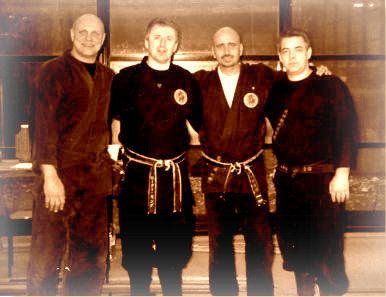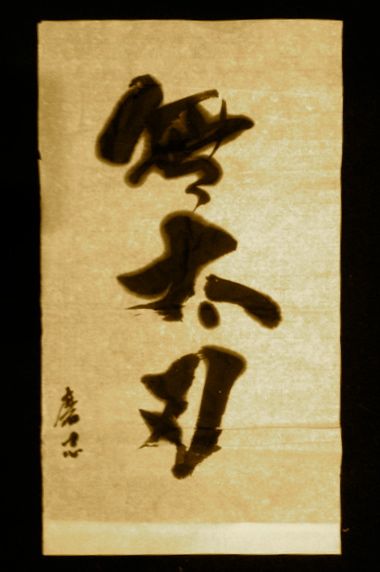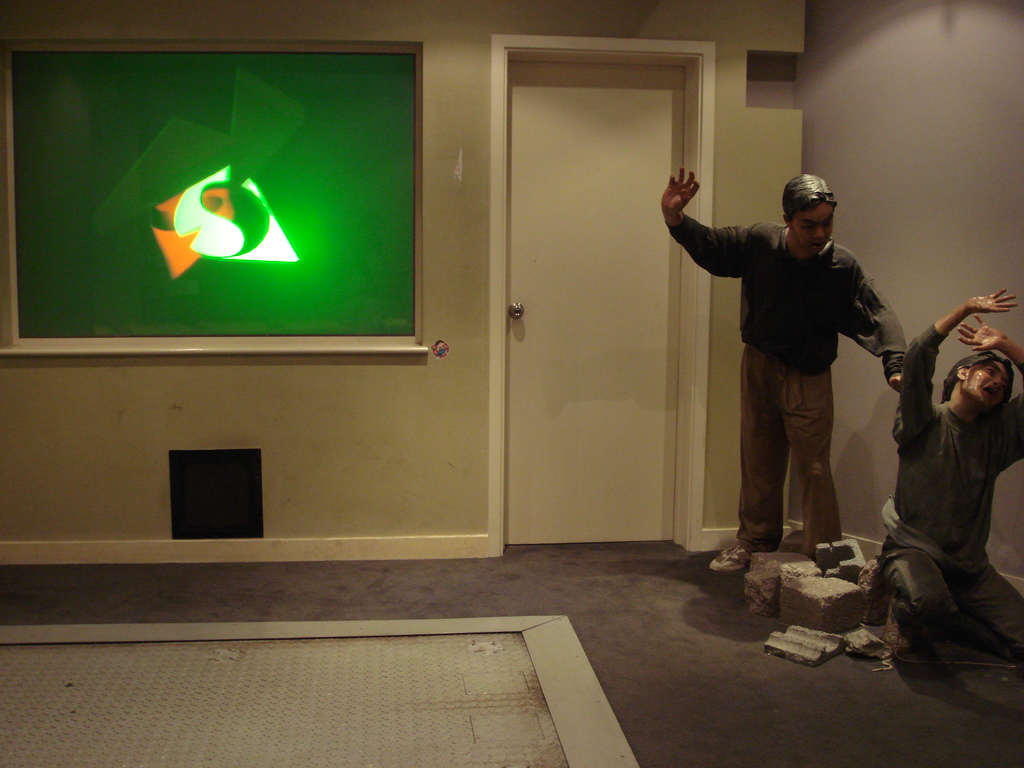Sanshin: Body & Mind Are Unity
From Shiro Kuma's Weblog by kumablog
From Shiro Kuma's Weblog by kumablog
From Budoshop by BUDOSHOP.SE
A seminar in Kaigozan Dojo with Shawn Gray from Japan.
This was the 5′th seminar with Mr.Shawn Gray at Kaigozan Dojo in Stockholm Sweden, and the third this year. This time he taught many techniques which he has trained in Japan since his last visit in June. Koteki Ryouda Juppou Sessho no Jutsu (the 2003 Bujinkan theme).
Ukemi, Taijutsu, and Kunai.
Recorded in Stockholm, Sweden November 2003
Note: The instructions is in English and there is no sub titles on this VCD
Shawn left behing 10 years of Karate and Kendo to begin Bujinkan training in Canada after returning from a 1-year stay in Japan in 1990. After a training visit in 1995, he relocated to Japan permanently in January of 1997. Shawn passed the godan test in January of 1999, and in 2000 at the urging of Hatsumi sensei established a dojo, the first Bujinkan dojo in Japan led by a civilian foreigner. Shawn has regularly served as interpreter for Dr. Hatsumi and has translated much of Senseis writing into english. He has been regularly invited to give seminars in Europe , North America , and Asia.
More info about Shawn http://bujinkan.graycastle.com
Click here for more information about our download files and how it works!…
From Budoshop by BUDOSHOP.SE
The Tuesday training theme (after Kaigousuru) was Rokushaku Bôjutsu, many variations and ideas on how to defend against someone taking control of your staff and then attacks. Principles and ideas from Gyokko-ryû and this years Bujinkan theme was also covered in detail.
The training was led by Shawn Gray who is a well known and respected instructor in Bujinkan Dojo.
Recorded in Stockholm, Sweden May 2005
Note: The instructions is in English and there is no sub titles on this Video
Click here for more information about our download files and how it works!…
From Budoshop by BUDOSHOP.SE
The Thursday training theme was how to defend yourself if one arm is injured and you cant use it at all, this session also finished of with some defences against knife attacks.
The training was led by Ed Martin, Sheila Haddad and Shawn Gray who all are well known and respected instructors in Bujinkan Dojo.
Recorded in Stockholm, Sweden May 2005
Note: The instructions is in English and there is no sub titles on this Video
Click here for more information about our download files and how it works!…
From Shiro Kuma's Weblog by kumablog
The first version (tcj1) was a sketch.
The second version of 1983 (tcj2) a prototype. A beta version.
The third version of 1987(tcj3), the Tenchijin 1.0. Unfinished but good enough.
Today in 2013, some 30 years after the Beta version (tcj2), I am surprised to see many high ranks trying to discover a new hidden truth by basing their teaching on the first tries by sensei.
But I wonder how can these high ranks be so wrong in their analysis?
The tenchijin was an attempt to summarize all the basics of the nine schools into a single tool to make it easier to enter the specific study of the Bujinkan Ryûha.
Please keep in mind that:
With all that in mind, please see the overall logic followed by sensei since the death of his mentor:
Sensei can be called many names but “stupid” is definitely not the appropriate one!
From Shiro Kuma's Weblog by kumablog

Memories: picture taken during one of the first Shi Tennô seminar organized by Steve Byrne in 2001 in Trinity College in Dublin.
Watching the nice blue sky through the window, I began to think about the next Yûro Shitennô Paris Taikai next July in Paris.
This seminar have been going on for more than ten years and it has always been a pleasure to welcome you all in our dôjô.
Many of you are already familiar with this extraordinary seminar but I think it is time to explain its origin once again for those of you who aren’t.
Around the year 2003, I was on the phone with Pedro and we were speaking of the “good old days” when the Shi Tennô could meet twice a year for a joint seminar called “Shi Tennô Seminar” (see picture above). But at the turn of the century, these seminars were not organized anymore. Many reasons for that.
First of all, the financial risk of having the 4 Shi tennô for a two days seminar was too big. Second, since our beginning (the first Shi Tennô took place in 1993), many new high rank instructors arrived on the market and there were more seminars available. Today each weekend in a 500km radius, there are at least two or three seminars organized.
Also our personal seminars schedule being so full we had some difficulty putting up a common date together.
Over the phone, we decided to organize it ourselves and this is how the first Paris Taikai was created in 2003. It was such a success that I decided to continue organizing it year after year. This year is the 10th one!
But what is a Paris Taikai?
Until the year 2002, Hatsumi would come to Europe to give three days seminars, they were called Taikai. I attended over 30 Taikai since the first one organized by my friend Peter King. The Paris Taikai was meant to replace the absence of sensei in our countries.
When we decided to organize the Paris Taikai, Sensei approved the idea and called it: “Yûro Shi Tennô Taikai”. Yûro 融朗 means “brightness”but is also a pun with “europa” pronounced by Japanese “yuropa”. Basically this is the Taikai organized by the European Shi Tennô: Peter, Sven, Pedro, and me.
The Paris Taikai follows the same structure as the Taikai of the past where we used to train during three days. But this one is also different as we train in three different dôjô at the same time. Also the group of participants is divided into 4 groups: beginners, intermediates, advanced, shidôshi. We make sure that each group is about the same size.
The Bujinkan France teached in a facility that is made of three dôjô: 1 big dôjô (150 to 200 people) with mats and two smaller ones (around 60-80 m2), one with mats and one with wooden floor. Trainings are conducted in the three dôjô at the same time and each hour teachers and students are changing location.
Each hour one group is taught by one Shi Tennô in the two small dôjô, and two groups (always beginner-intermediate; or advanced-shidôshi) are taught by 2 Shi Tennô in the big dôjô. This is why whatever your technical level you will receive the teaching that you can understand. Many times when you are attending a seminar, the teacher has to teach a certain level. When he is teaching high level, beginners are lost, and conversely when he is teaching basics, the advanced practitioners are bored! This is not happening at the Paris Taikai.
This Taikai is also the chance to meet people from all over the world (there are around 15 to 20 countries attending) and to connect or reconnect with friends from everywhere.
When you register for the Taikai (which is limited to 150 participants) you get:
Also do not forget that this event takes place right during the weekend of the French National day, and Paris is full of laughter, fireworks, drinking, dancing; and the weather is around 30° Celsius.
But if Paris is a nice city to visit in summer; if the techniques demonstrated are done by 4 of the more advanced students of Sensei; above all what you are getting out of such an event is hours of happiness and friendship, and for me this is the most important part of a Taikai. The techniques are always nice but the feeling of belonging to a community is even better. This seminar is Bujinkan at its best!
Places are limited and pre-booking is going very fast this year so if you are interested to join us, please follow the link below:
http://www.budomart.com/acatalog/Online_Catalogue_PARIS_TAIKAI_36.html
And if you do not come some other Bujinkan member will be happy.
Rokkon Shojo!
From Shiro Kuma's Weblog by kumablog
From 8þ Kabutoshimen by admin
If you don’t understand this, I question your whole reason for training martial arts! We are supposed to be role models and smarter than common people, at least that is what we are telling each other with varying confidence. Most people in Bujinkan seems to be caught up is some kind of romanticised imagination of being some kind of ninja warrior, far from today’s reality. It is fun dreaming away fighting with swords and shurikens. We talk about defending against what can not be seen, but have you even thought about what that means?
I don’t like to bring in politics and religion into training because we are all free to believe what we want. But when the politics stray from democracy and becomes tyranny I have to speak up against it. It is easy to see what is happening in USA with all these crazy events. I’m not talking about the two brothers bombing the Boston marathon, I’m talking about the media blowing things out of proportion scaring people and 9000 police army closing a whole town busting into innocent people’s homes taking away their constitutional rights. At the press conference the police say that we should not look at any other pictures than those they approved, telling us to only trust them. Now media is criticising themselves for jumping into conclusions and imply that in the future they will stick only to the official story without questioning. To me that is a strong sign on tyranny taking over.
You must understand that there is a lot of money to be made keeping people scared, just follow the money and you will understand.
And now we got CISPA coming, Obama said he will veto it, we’ll he said that about NDAA (indefinite jail without court or jury!) to and then signed it anyway New Year’s Eve 2011/12 in “secrecy”…







The post What good is your martial arts skills against a government tyranny? appeared first on 8þ Kabutoshimen.…
From 術心悟 by goshinarts

If you practiced martial arts or zen, perhaps you recognize these Chinese characters. The first one, Mu is a negative and can mean among a vast array of meanings, nothing, not, no, nothingness and more. The second and third characters are a pair, pronounced Tachi, meaning just that, a Tachi is a type of curved sword usually worn hung at the waist blade down that was used during the warring periods in Asia.
This year in our martial arts training we are exploring movement while wielding a Tsurugi, another type of double edged sword that predates the Tachi. But notice the emphasis is on movement and not on the using the tsurugi itself. This is a very important point. Perhaps related to another recent post, Mu Tou Dori, you will enjoy this pun (which was originally painted by Hatsumi Sensei but I did not photograph it. So you must suffer my brush!). It is a simple pun but made thru the use of three different languages! The characters are Chinese, the expression itself is a Japanese expression based but based on the English language!
At first glance it looks like Nothing Tachi. But when we change the Nothing to No, it becomes “No Tachi”. Pronounced this way in the Japanese accent it becomes English, “No Touch”! This Japanese expression is use for situations that are perhaps dangerous, so “No Touch”, or maybe we distance ourselves from them. Perhaps it can imply a lightness of approach. What does it mean to you? If you have been training for a long time or even just beginning your journey, may this pun, in conjunction with the prior post, Mu Tou Dori, inspire and enlighten.
From Bujinkan Santa Monica by Michael
 |
| 地震體驗室 photo by Anav Rin |
"We're doing these things that can't be understood. And in real life people are killed by things they can't see or understand. We are studying how to survive things you can't understand. No matter how many techniques you study, they might actually interfere with your ability to live if you get stuck on them. And bit by bit you just end up collecting techniques. So get rid of those. Erase them."These points are at the heart of what it means to study the Bujinkan. If you are not studying this way, or you are unwilling to look at your own training methods through this lens, you cannot understand Soke's art. And I see MANY students and teachers who refuse to look at this.